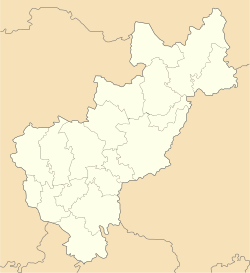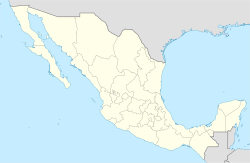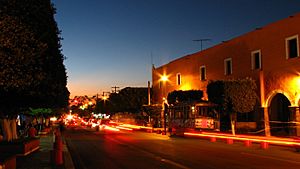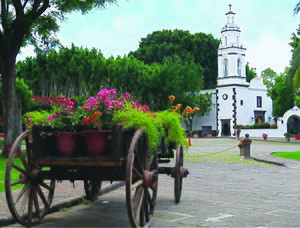San Juan del Río facts for kids
Quick facts for kids
San Juan del Río, Querétaro
|
|
|---|---|
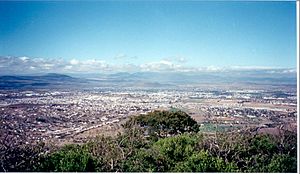
Partial view of San Juan del Río (taken from "Cerro Gordo" hill).
|
|
| Country | Mexico |
| State | Querétaro |
| Municipality | San Juan del Río Municipality |
| Area
(municipality)
|
|
| • Total | 799.9 km2 (308.8 sq mi) |
| Population
(2015)
|
|
| • Total | 268,408 (city); 305,000 (municipality) |
| • Summer (DST) | UTC-6 |
| HDI (2000) | 0.8035 |
| GDP (per capita) | US$6.980,00 2000 |
| WOEID | 143928 |
| Website | sanjuandelrio.gob.mx |
San Juan del Río is a lively city in the central Mexican state of Querétaro. It's also the main city for the surrounding San Juan del Río Municipality. In 2015, the city had about 268,408 people, and the whole municipality had around 305,000.
San Juan del Río and its municipality have the second-largest population in the state. The municipality covers an area of about 799.9 square kilometers (308.8 sq mi).
The city is located on Mexico's central plateau, about 50 kilometers (31 mi) southeast of the state capital, Santiago de Querétaro. It sits at an elevation of 1,922 meters (6,306 ft) above sea level. While it's known for its beautiful opals, which are mined nearby, San Juan del Río is also a big farming area. Farmers here grow corn, wheat, sugarcane, beans, alfalfa, fruits, and raise livestock. You can also find several wineries in the area.
San Juan del Río is well-connected to Santiago de Querétaro and Mexico City. It has a main railway line and is on Federal Highway 57.
Contents
Discovering San Juan del Río's Past
The city of San Juan del Río was founded on June 24, 1531. This date is important because it was the Feast of Saint John the Baptist. It was founded by Fernando de Tapia, an Otomí leader who became Catholic. San Juan was one of the first Spanish settlements outside the Valley of Mexico. It marked the start of Spanish settlement in Northern and Western Mexico. The city of Querétaro was founded just one month later. San Juan del Río became a very important stop for travelers. It was on the main route to rich mining areas like Guanajuato, Zacatecas, and San Luis Potosí.
Ancient Roots: The Pre-Hispanic Era
Long before the Spanish arrived, the area around San Juan del Río was home to the ancient Otomí people. Discoveries along the river show that people lived here as early as 400 BC. These early settlers were skilled farmers and gatherers. They had a complex culture and were one of the oldest organized groups in the Mexican highlands. The Otomí made great progress in growing crops like maize (corn), beans, pumpkins, and agave.
The Otomí people gathered near a hill called Techimacit, which is now known as Barrio de la Cruz. They built their homes in the valley formed by the river. They called their village Ixtachichimecapan, meaning "land of white Chichimecas." Their chief was Mexici, who later took the Christian name John.
How the City Was Founded
San Juan del Río was officially founded as a village for indigenous people on June 24, 1531. It was named after San Juan Bautista because of the date. The "del Río" part was added because it was located by a flowing river. Every year around this date, the city holds a big fair. The fair includes bullfights, games, concerts, and other fun cultural events.
San Juan del Río was an important frontier city. It helped protect the area during conflicts between different groups. Later, it became a key stop between the mining centers of Zacatecas and San Luis Potosí and Mexico City.
Life in the Colonial Age
After the village was founded peacefully, building and organizing began. The first chapel was built by Franciscan religious leaders. The main streets were laid out in a large area of good land. The village of San Juan del Río was built on a hillside near a valley surrounded by hills.
Early building projects in the 1500s focused on organizing the town. A major problem was crossing the San Juan River during the rainy season. This affected both the local people and the government. It was a vital route for silver shipments from the North to Mexico City. A bridge was built in 1561 to solve this problem. It is believed that Fray Sebastián de Aparicio built it. This bridge had to be rebuilt in 1621 because of constant use.
The 18th Century and Beyond
At the start of the 1700s, the bridge was rebuilt again. This new bridge was much stronger and more beautiful than the earlier ones. It was built with five arches and stone plates, which are still there today. This important bridge was finished on January 23, 1722.
During this time, churches, temples, and convents also became more common. The old part of San Juan del Río is similar to Querétaro. It has two types of street layouts. One is an irregular layout, which was likely the ancient indigenous area. The other layout is more organized, following Spanish building practices.
In 1670, the first school for girls was officially opened. It was called "Beaterio de Nuestra Señora de los Dolores." In 1672, the Hospital and Convent of San Juan de Dios were founded. They cared for sick people in the city and travelers. Today, this building is used by the Autonomous University of Querétaro. A new parish church began construction in 1693. It was dedicated to the city's patron saint, St. John the Baptist, on July 25, 1729. Around the same time, the temple and convent of Santo Domingo were completed.
On April 3, 1847, during the war between Mexico and the United States, San Juan del Río was given the title of "city."
By 1855, industries and trade grew a lot. The city had barbershops, carpentry, tanneries, breweries, blacksmiths, wheat mills, bakeries, and many other businesses.
In 1863, Benito Juarez, a famous Mexican president, stayed in San Juan del Río while traveling. In 1867, Maximilian of Habsburg, who was briefly emperor of Mexico, made one of his last speeches in the city. He urged people to defend Mexico's independence. Later, he was executed in Querétaro.
In the late 1800s, San Juan del Río became part of the railway network. A "Round House" for repairing steam engines was built here. From 1960 to 1970, San Juan del Río saw big changes. It grew a lot in terms of industry, trade, and communication. These changes have made it the second most important municipality in Querétaro today.
The City's Shield
On June 24, 1984, San Juan del Río got its new official shield. A painter named Héctor Raúl Rojas López designed it. The shield is shaped like a traditional coat of arms. It has two ribbons that come down from the top and join at the bottom.
The shield is divided into three parts, each showing something important about the city:
- The top middle part shows Saint John the Baptist, the city's patron saint.
- Below that, there is a picture of the five-arched stone bridge. This bridge represents the city's founding, its religious history, and its growth during the time of the viceroys.
- The bottom part is divided into two sections. The left side shows an Otomi symbol, representing the city's ancient roots before the Spanish arrived. The right side shows the Kingdom of Spain, representing those who founded the city.
- At the very bottom of the shield, a banner has the city's name: San Juan del Río.
The shield uses colors like gold, red, blue, black, green, brown, and a flesh tone.
Puente de la Historia (Bridge of History)
The famous stone bridge, also known as the Bridge of History, started being built on February 9, 1710. The Mexican architect Pedro de Arrieta designed it. The bridge was finished on January 23, 1711. It quickly became one of the busiest bridges in Mexico. It was the main connection between Mexico City and the northern states.
This bridge is very important historically. It was the main route for many people who fought during the Mexican Independence and the Mexican Revolution.
In February 2010, the bridge celebrated its 300th anniversary. It remains a symbol of the city's rich past and its growth over centuries. The San Juan River flows under this bridge, and thousands of ducks migrate to this river every year. You can see white, Canadian, and European ducks, and sometimes even geese and white swans!
Geography and Nature
San Juan del Río is located in a valley that is great for farming. It has many underground streams with warm springs, about 37.5 degrees Celsius (99.5°F).
The valley is surrounded by mountains: La Llave (2,450 meters), Xajay (2,750 meters), Scholastics (2,800 meters), and Jingó (2,500 meters).
The San Juan River is the main river in the municipality and the state. It starts in the State of Mexico. After leaving the municipality of Tequisquiapan, it becomes the Río Moctezuma. This river then forms the natural border between Querétaro and Hidalgo. Finally, it flows into the Golfo de México at the port of Tampico as the Rio Pánuco.
Climate in San Juan del Río
San Juan del Río has a semi-dry temperate climate. Most of the rain falls during the summer months. Snow is very rare in this area, though the hills northeast of the city have sometimes had a light layer of snow.
| Climate data for San Juan del Río (1951–2010) | |||||||||||||
|---|---|---|---|---|---|---|---|---|---|---|---|---|---|
| Month | Jan | Feb | Mar | Apr | May | Jun | Jul | Aug | Sep | Oct | Nov | Dec | Year |
| Record high °C (°F) | 29.5 (85.1) |
31 (88) |
33 (91) |
35.3 (95.5) |
41 (106) |
37 (99) |
35 (95) |
31.7 (89.1) |
32.2 (90.0) |
31 (88) |
30 (86) |
29 (84) |
41 (106) |
| Mean daily maximum °C (°F) | 23.5 (74.3) |
25.4 (77.7) |
28.8 (83.8) |
32 (90) |
36 (97) |
32 (90) |
31 (88) |
31 (88) |
29 (84) |
25.5 (77.9) |
26 (79) |
23.2 (73.8) |
36 (97) |
| Daily mean °C (°F) | 17.2 (63.0) |
16.2 (61.2) |
19.1 (66.4) |
19.5 (67.1) |
20.5 (68.9) |
21.3 (70.3) |
20.6 (69.1) |
20.7 (69.3) |
18.3 (64.9) |
18.4 (65.1) |
18.6 (65.5) |
15.5 (59.9) |
17.2 (63.0) |
| Mean daily minimum °C (°F) | 8.1 (46.6) |
6.8 (44.2) |
8.2 (46.8) |
11 (52) |
13 (55) |
14 (57) |
15 (59) |
14 (57) |
13 (55) |
11 (52) |
9 (48) |
4.7 (40.5) |
4.7 (40.5) |
| Record low °C (°F) | −10.6 (12.9) |
−5.1 (22.8) |
−0.7 (30.7) |
2.6 (36.7) |
5.2 (41.4) |
5.5 (41.9) |
4.0 (39.2) |
8.1 (46.6) |
4.5 (40.1) |
2.3 (36.1) |
−0.5 (31.1) |
−2.0 (28.4) |
−10.6 (12.9) |
| Average precipitation mm (inches) | 0.8 (0.03) |
15 (0.6) |
21 (0.8) |
38 (1.5) |
80 (3.1) |
140 (5.5) |
130 (5.1) |
121 (4.8) |
132 (5.2) |
73 (2.9) |
19 (0.7) |
11 (0.4) |
780 (30.7) |
Local Plants and Trees
The plants and trees in San Juan del Río are typical of the "Mezquital" area. This region is found between 1,400 and 2,000 meters above sea level. You'll find small trees and large shrubs here.
Common plants include mesquite, piru (or pirul), gobystick, cat's claw, reed, huisache, garambullo, granjeno, and nopal (prickly pear cactus). You can also see desert plants like biznaga (barrel cactus) and organ pipe cactus.
Fun Things to Do in San Juan del Río
San Juan del Río offers many fun activities and places to visit!
- San Gil Golf Club: Just a few minutes from the city, you'll find the San Gil Golf Club. It has an 18-hole golf course that hosts big national and international tournaments. There's also a beautiful lake, a clubhouse, and large gardens.
- Paso de los Guzmán Ecological Park: This park has great sports facilities. You can find basketball courts, soccer fields, volleyball courts, a rollerblade track, and a running track. There are also picnic areas and playgrounds for kids. It's perfect for a fun family weekend.
- Maquío Sports Unit: This sports center has an auditorium for sports and cultural events. It also features basketball courts, volleyball courts, a playground, a full-size soccer field, and an athletics track. It's a great place for recreation and sports.
- San Juan Sports Unit: Located on the road to Tequisquiapan, this center has several soccer fields, volleyball courts, and basketball courts. It also has playgrounds and a swimming pool with diving boards.
- José María Morelos y Pavón Cultural and Convention Center: This large center offers both sports and cultural facilities. It has an auditorium that can hold three thousand people, outdoor volleyball and basketball courts, and a cafeteria.
Historic Buildings to Explore
- History Bridge: Located on Benito Juárez Avenue, this bridge was a required stop for travelers and goods going to northern New Spain. It was a customs stop where taxes were collected. The bridge was built between 1710 and 1711 by architect Pedro de Arrieta. It became the most used bridge connecting Mexico City with mining areas like Guanajuato and Zacatecas. It was also a key route for those who fought in Mexico's Independence and Revolution.
- Diocesan Shrine of Our Lady of Guadalupe: This beautiful church is located in front of Plaza Independencia. Its construction began in 1689. It has an elegant neoclassical design. Today, the Virgin of Guadalupe is honored inside.
- Temple of the Lord of Sacromonte: This church started being built in 1826. It was officially opened in 1831 with religious and public celebrations.
- Temple and Ex-Convent of Santo Domingo: Founded in 1690, this convent was a place for sick religious people. It held the remains of important figures like Miguel Hidalgo y Costilla, a leader of the Independence movement. Today, the municipal government uses this simple but historic building.
- Parish Temple of St. John the Baptist: The first church in the village was on this site. The current church was built in the early 1700s. It was originally called the Temple of the Sacred Heart. In 2006, it became the Parish of San Juan Bautista.
- Portal of the Tithe: This is the most important cultural center in San Juan del Río. It has art galleries, a photo theater, a public library, and the Municipal Historical Archive. It was located on the old "Camino Real de Tierra Adentro," a major route for minerals, goods, and people during the colonial period. The wealth from this route can still be seen in the grand haciendas (estates) nearby. You can take a "Tour de las Haciendas" to visit them.
Public Squares to Relax In
- Independence Square: Located in the city center, this square features a column built to honor Empress Charlotte. After the empire fell, it was dedicated to Mexico's Independence. It has a marble plaque from 1865.
- Family Garden Square: This square became public after the Temple of the Lord of the Sacred was built in 1832. It has a water fountain. In 1994, a marble statue of a family was placed here, giving the square its current name.
- Founders' Square: This area was once part of the Sacred Heart temple and its cemetery. It was later known by different names before being remodeled in 1981. It now has a kiosk and a monument honoring the founders of San Juan del Río.
The Procession of the Farolitos
The Procession of the Farolitos is a special tradition in San Juan del Río. It happens every year on December 11. This procession marks the start of the festivities for the Virgin of Guadalupe. It began in 1948.
Thousands of people, including church groups, schools, and city officials, join this procession. They light up Juarez Avenue with thousands of "farolitos" (small lanterns) as they walk to the Shrine of Our Lady of Guadalupe.
In the past, people carried candles and torches. Today, they carry paper or cellophane lanterns. The procession starts at the Temple of St. John of God and ends at the Parish Atrium, where a special mass is held.
Participants say the procession represents the journey of life and their faith in the Virgin of Guadalupe. The farolitos symbolize this faith. In recent years, children dress as little shepherds to honor Juan Diego, who saw the Virgin of Guadalupe. So, every December 11, the city glows with light and prayers for the Queen of Tepeyac.
Famous People from San Juan del Río
Many notable people have come from San Juan del Río:
- Cristóbal Sánchez de Guevara (1580-1644): A lawyer and university rector.
- Reverend Mother Beatriz María de Jesús Flores (1665-1751): Founder of a school for girls.
- José Mariano Perrusquía y Rubio (1766-1827): A famous sculptor whose works are found in many states.
- Luis G. Quintanar Soto y Ruiz (1772-1837): A distinguished general in the War of Independence.
- Juan M.a Wenceslas Sánchez de la Barquera y Morales (1779-1840): A brilliant lawyer, philosopher, writer, and politician.
- Ignacio Reyes Rayón (1804-1883): A liberal politician and senator who signed the Constitution of 1857.
- Master Maria Nestora Téllez Rendón (1828-1889): A teacher, poet, and writer who achieved much despite being blind.
- Jannet Alegría Peña (1987): A talented Taekwondo athlete. She won a Bronze medal at the 2011 Pan American Games and a Gold Medal at the Pan American Taekwondo Championship. She also competed in the 2012 London Olympics.
Cultural Events and Celebrations
San Juan del Río hosts several cultural events throughout the year:
- January 17: Feast of San Antonio (includes the Blessing of the Animals)
- February 2: Day of the Candelaria (Blessing of the Seeds)
- March 1: Jesusito de la Portería
- March 3: Feast of the Holy Cross
- Around June 24: City Fair, Feast of Patron Saint Saint John the Baptist, and Anniversary of the City's Foundation.
- November 22: Feast of Santa Cecilia
- December 11: Procession of the Farolitos
Entertainment in San Juan del Río
- City Fair: The San Juan Fair is celebrated in June. It commemorates the city's founding and honors its patron saint, John the Baptist.
- Goal 7 San Juan del Río: A Football 7 field located near the México-Querétaro highway.
- Liverpool SJR: A large department store located in Plaza Galerías mall.
- Museo de la Muerte: A unique museum about death.
See also
 In Spanish: San Juan del Río (Querétaro) para niños
In Spanish: San Juan del Río (Querétaro) para niños


